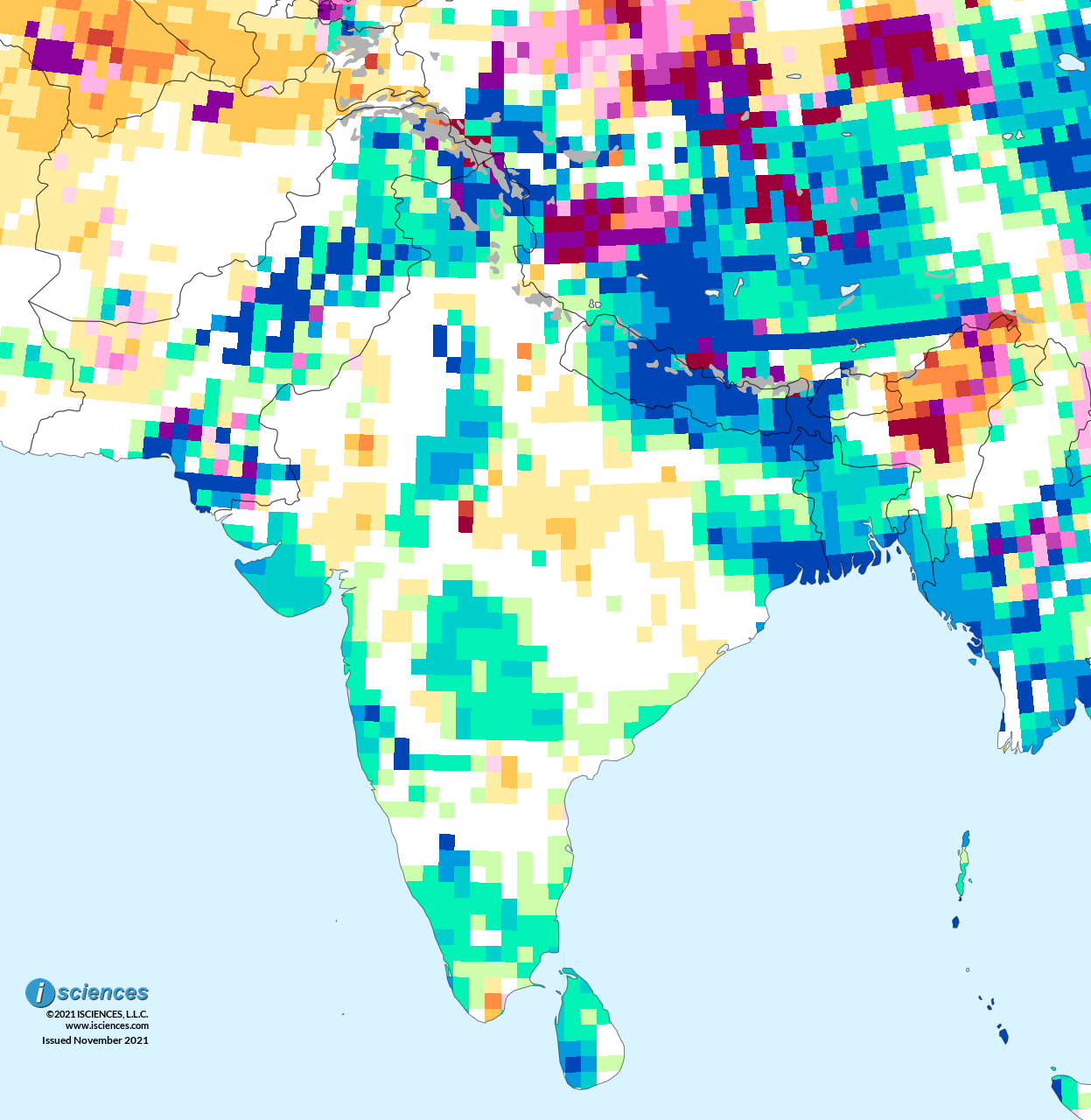South Asia: Water surplus will persist in Nepal, India, Bangladesh
20 November 2021
THE BIG PICTURE
The 12-month forecast through July 2022 indicates water surpluses of varying intensity in several regions of India, throughout Nepal and Bangladesh, and much of Pakistan and Sri Lanka.
In India, surpluses will be exceptional in the Ganges Delta in West Bengal, downgrading as they reach inland through Jharkhand. Surpluses are also forecast in the Ganges Plain in Bihar and Uttar Pradesh in regions bordering Nepal, and in India’s far north where anomalies will be exceptional. Severe to extreme surpluses are expected in eastern Rajasthan, becoming more intense in its northern neighbor, Haryana. Generally moderate to severe anomalies are forecast for Gujarat, coastal Maharashtra and the state’s eastern half into Telangana, and southern India from Karnataka through Kerala and Tamil Nadu. India’s Far Northeast, however, will see deficits ranging from moderate to exceptional, and a few small, isolated pockets of deficit are forecast in the center of the country.
In Nepal, extreme to exceptional surpluses will be widespread, reaching east into Bhutan. Surpluses are expected throughout Bangladesh as well, severe to extreme overall but exceptional in the Ganges Delta. Sri Lanka can expect surpluses, moderate in the nation’s northern half but more intense in the southwest. In Pakistan, surpluses will be widespread in the Indus River Basin with exceptional anomalies in the center of the country and in the south including Karachi. Moderate deficits are forecast in northern Afghanistan.
FORECAST BREAKDOWN
The 3-month composites (below) show the evolving conditions in greater detail.
The forecast through January 2022 indicates a pattern of anomalies like that observed in the prior three months though surpluses will increase in southern India and deficits in Afghanistan will nearly disappear. India can expect surpluses in the far north; the Ganges Plain regions bordering Nepal, and in West Bengal; from eastern Rajasthan north into Haryana; Gujarat; coastal Maharashtra and the central region of the state reaching to Hyderabad, Telangana; and the southern states of Karnataka, Kerala, and Tamil Nadu. Regions where anomalies will be intense include West Bengal, from Karnataka into Kerala, and Gujarat. Deficits are forecast in the Far Northeast and some pockets of moderate deficit will emerge in western Rajasthan. Surpluses will be exceptional in Nepal, severe to extreme overall in Bangladesh, and moderate overall in Sri Lanka. While surpluses of varying intensity will persist in Pakistan, particularly in the north, transitional conditions (pink/purple) are also expected. Deficits will shrink in Afghanistan and surpluses are forecast near Mazar-e Sharif and Herat, and in the Upper Helmand River Watershed.
From February through April 2022, surpluses will persist in many areas of India previously noted though transitional conditionals are expected in Gujarat and coastal Maharashtra. Deficits will increase in the Far Northeast. Widespread surpluses will continue in Nepal and Bangladesh while surpluses in Sri Lanka shrink. In Pakistan, surpluses will shrink in the north but re-emerge in the center of the country. Nearly normal conditions are forecast in Afghanistan with surpluses near Mazar-e Sharif.
The forecast for May through July 2022 indicates lingering surpluses primarily in West Bengal and its neighbors, southeastern India into Sri Lanka’s northern tip, Jammu and Kashmir, Nepal, and Pakistan. Deficits are forecast in India’s Far Northeast.
Please note that WSIM forecast skill declines with longer lead times.
IMPACTS
Drought combined with political upheaval and consequent economic fallout have put 19 million Afghans in danger of acute food insecurity according to a report from the United Nations Food and Agricultural Organization. Farming and herding families, deep in debt, are abandoning their parched land.
Facing the unthinkable choice between watching offspring starve or selling young daughters, some fathers have resorted to accepting “bride prices,” negotiating arranged marriages to survive.
Rainstorms in early November triggered flooding in Chennai and other areas of the southern Indian state of Tamil Nadu. Four deaths were reported in the state and road, rail, and air travel were disrupted in Chennai. One enterprising entrepreneur in the city of over 7 million people began delivering fresh vegetables and fruits via a fleet of paddleboards, accessing talent from a local surfing school.
Flooding, landslides, and lightening strikes claimed 20 lives in Sri Lanka after weeks of heavy rain. Over 62,000 people were affected by the storm that displaced 5,000 and damaged 1,000 homes.
NOTE ON ADMINISTRATIVE BOUNDARIES
There are numerous regions around the world where country borders are contested. ISciences depicts country boundaries on these maps solely to provide some geographic context. The boundaries are nominal, not legal, descriptions of each entity. The use of these boundaries does not imply any judgement on the legal status of any territory, or any endorsement or acceptance of disputed boundaries on the part of ISciences or our data providers.
Subscribe to our monthly Water Watch List
Search blog categories
- *Precip/Temp Outlooks 101
- *Press Releases 1
- *Special Topics 19
- *Water Watch Lists 118
- Africa 128
- Australia & New Zealand 112
- Canada 114
- Central Asia & Russia 112
- East Asia 113
- Europe 119
- Mexico & C. Amer. & Carib 117
- Middle East 122
- Proof Point 1
- South America 127
- South Asia 118
- Southeast Asia & Pacific 121
- United States 118
Search blog tags

